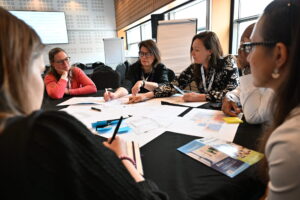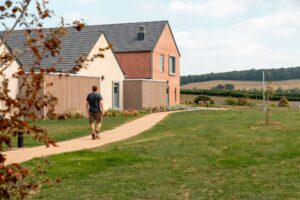In our current world stretched of resources: time and money are valuable commodities when it comes to getting design right. Why should we engage with stakeholders if it slows down the process of building things, when every project was really needed yesterday? Why use up valuable NHS staff time to go above and beyond when their day jobs are hard and busy enough already? And why ask patients about their experience when they’ve been successfully treated in healthcare environments? Is it really needed? Surely designers know how to fix the problem?
The answer, in my opinion, is so straightforward that I feel a little bewildered when I hear examples of limited or no engagement.
Architects and designers start their fledgling careers by being guided towards beautiful design. Yes, it has to respond to a brief, but if it ends up being beautiful to the eye, sometimes that’s considered enough to be ‘good’. But for design to truly be good, it needs to respond to each user’s needs in a positive way. If it doesn’t solve a problem, and make life better, why spend already challenging budgets in the first place?
Whilst around 1 in 4 of us will experience a mental health challenge each year[1], the majority of us do not. How do we really know how it feels to be unwell? As designers we must listen to those with lived experience, together with staff teams from clinical, estates and facilities management to respond with designs that work for everyone; clinically and practically.
What is Design? (Oxford English Dictionary)
Essential Meaning of design
1: to plan and make decisions about (something that is being built or created)
2: to plan and make (something) for a specific use or purpose
Design is therefore simply a response to a brief, set either by the designer itself, or by the end-user, or future owner of the product.
- If a design fails to respond to the end users’ needs, then designers are only designing to their own interpretation of the brief.
- If it doesn’t respond to the end user’s needs then it could well fail to provide any real value, stand accused of wasting money, or, in extreme cases, be dangerous. Someone may present an argument for not listening to our clients’ stakeholders during the design development phase, but I’m not too sure what that would look like..?
In the design of healthcare settings, the key stakeholder is often the clinical and estates teams. Acute healthcare is functional by nature, treating something that needs ‘fixed’. The patient will likely visit a number of times, for short periods – but are they fully involved in the success of their treatment? Their time spent in the clinical setting is relatively brief and while efficiency, clinical flows and clinical safety is rightly a high priority, designing-in natural light and views of nature results in whole the environment immediately becoming more welcoming and less institutional. Hard, infection-preventing finishes are an accepted and expected necessity of the hospital environment, but service-users can still be canvassed for their perspective on the final proposals. I guess the Big Question is, is their input critical to the future success of treatment?
When we’re thinking about design for mental health settings, it can be argued that the complexity of the design challenge is greater. Designs need to provide a safe place where people, during (self-evidently) vulnerable and distressing times in their lives, can be supported towards recovery. Safety is not one-dimensional, it cannot solely be physical safety, psychological safety is crucial too. If a service user doesn’t feel safe, they are less likely to proactively engage in therapy and activities aimed at optimal recovery.
None of us want to live in a house that we don’t feel comfortable and safe in. For the duration of their stay, the mental health buildings we’re talking about are home. We therefore need to listen, in order to understand. So while large open plan spaces with great observation may be ideal for staff, they may feel overwhelming and unsafe to some patients. ‘Safe’ doesn’t automatically mean ‘good’ when we all react differently to different settings. A big open day-space with high ceilings may feel bright and full of natural light, but it may not feel safe to someone who isn’t yet ready to encounter the other 17 unwell people on the ward. It is also important to appreciate that what suits one mental health diagnosis might not suit another, particularly when designing for specialist learning disabilities, or different age groups.
So design for mental health environments simply can’t be successful if developed in any designer’s isolation. Each person with lived and worked experience can inform the design process with valuable insight into how they felt during residential stays. What helped, what hindered? What made them feel safe and/or unsafe? What helped their recovery and/or hindered it? How can care be best delivered?
Engagement
Good engagement needs to be well planned, consistent, and undertaken throughout the design process. Good engagement will take stakeholders on a journey through exploring aspirations, as well as realisations; how things look, feel and function. It will explore what may work, and what might not, and will collect all views to analyse how multiple scenarios can be managed in the new building or space. In the early stages of engagement it can be useful to dis-associate ‘the now’ from ‘the future’. Working methods and practices may have evolved or have been necessarily adapted to suit existing old or sub-standard environments. Being ambitious about models of care without the constraints of a building envelope often allows stakeholders to describe their vision more freely. It will be the designer’s skill and experience which develops a design to realise the vision and facilitates flexibility for future adaptations.
Engagement is applicable to any element of design for mental health environments. A door may be strong enough to stand up to abuse, but is the anti-ligature ironmongery too physically safe to feel psychologically safe? The furniture may be robust and stand up to infection prevention tests, but how does it feel to lie on the bed to get some rejuvenating sleep?
From experience, one size never fits all. Good engagement needs to adapt to each situation – smaller groups, one-to-one sessions or larger events may appropriate for different groups of people, and different stages of design. Using a variety of tools, designers can draw from real experiences to clarify the brief and ensure the completed design reflects the needs of its users. Simple tools engage more easily – do you like a style or image, or not? How do you want the space to feel? Technology can also energise groups of stakeholders; virtual or augmented reality building walk-throughs, or hands-on mock-ups can be used throughout the design process, not only to help visualise and test the design, but to show how stakeholders needs and opinions have been incorporated. With Stakeholder engagement designers can often implement real-time changes in building layouts during engagement sessions. The design belongs to them, they are part of the team that designed it, and they understand why we can’t always get to the moon on a stick!
Engagement should encourage debate: design teams should respectfully challenge and question how and why a building or space needs to work, but stakeholders should be actively encouraged to challenge designers. If a space or building doesn’t reflect their vision or needs, tell them so. Engagement also needs to share feedback from other groups. The final design may be a compromise to some, whether in size of space, layout, landscape, furniture or colour. Managing expectations and developing the story throughout the lifetime of each project enables everyone to be involved at every stage, ensuring the only surprises at completion are nice ones.
So, what if we don’t engage?
If Stakeholder Engagement isn’t carried out there is a risk that the really important features of a design might be missed. It becomes the designer’s vision, not that of the health service, its staff and its users.
Similarly, Stakeholder Engagement carried out badly may do more harm than good. Excluding groups, not planning well enough to leave listening time, little or no updates / feedback on design development can all, at their worst, lead to disruptive behaviour from those not given the opportunity to contribute. Even more disappointingly, schemes completed and built without design engagement can lead to unhappy staff and service users who simply don’t like working a new building, or may not recover as well or as quickly as they might otherwise have.
Conclusion
Stakeholder engagement is a vital part of design and needs to listen to all stakeholders. Done well it will improve the design, and lead to improved clinical outcomes. Done badly, or not done at all, results in disappointment, disillusion and potential distress to the very people we are trying to help.
Written by Cath Lake, P+HS Architects with Lianne Knotts, Medical Architecture and Karen Howell, Iteriad
We would welcome your views and comments either here or over on the Design forum





